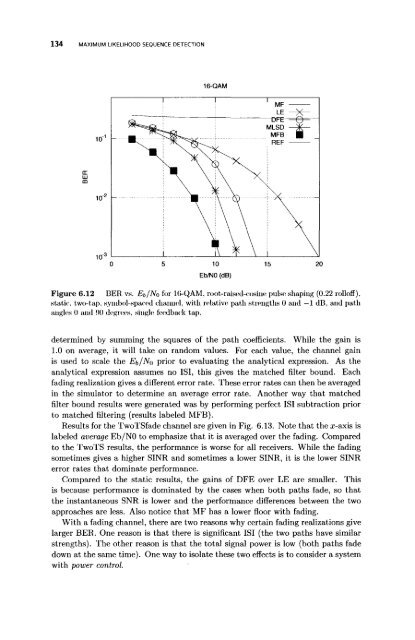mohatta2015.pdf
signal processing from power amplifier operation control point of view
signal processing from power amplifier operation control point of view
Create successful ePaper yourself
Turn your PDF publications into a flip-book with our unique Google optimized e-Paper software.
134 MAXIMUM LIKELIHOOD SEQUENCE DETECTION<br />
16-QAM<br />
0 5 10 15 20<br />
Eb/NO (dB)<br />
Figure 6.12 BER vs. E b /N 0 for 1G-QAM, root-raised-eosine pulso shaping (0.22 rolloff),<br />
static, two-tap. symbol-spaced channel, with relative path strengths 0 and —1 dB, and path<br />
angles 0 and !)() degrees, single feedback tap.<br />
determined by summing the squares of the path coefficients. While the gain is<br />
1.0 on average, it will take on random values. For each value, the channel gain<br />
is used to scale the Eb/N» prior to evaluating the analytical expression. As the<br />
analytical expression assumes no ISI, this gives the matched filter bound. Each<br />
fading realization gives a different error rate. These error rates can then be averaged<br />
in the simulator to determine an average error rate. Another way that matched<br />
filter bound results were generated was by performing perfect ISI subtraction prior<br />
to matched filtering (results labeled MFB).<br />
Results for the TwoTSfade channel are given in Fig. 6.13. Note that the z-axis is<br />
labeled average Eb/NO to emphasize that it is averaged over the fading. Compared<br />
to the TwoTS results, the performance is worse for all receivers. While the fading<br />
sometimes gives a higher SINR and sometimes a lower SINR, it is the lower SINR<br />
error rates that dominate performance.<br />
Compared to the static results, the gains of DFE over LE are smaller. This<br />
is because performance is dominated by the cases when both paths fade, so that<br />
the instantaneous SNR is lower and the performance differences between the two<br />
approaches are less. Also notice that MF has a lower floor with fading.<br />
With a fading channel, there are two reasons why certain fading realizations give<br />
larger BER. One reason is that there is significant ISI (the two paths have similar<br />
strengths). The other reason is that the total signal power is low (both paths fade<br />
down at the same time). One way to isolate these two effects is to consider a system<br />
with power control.



